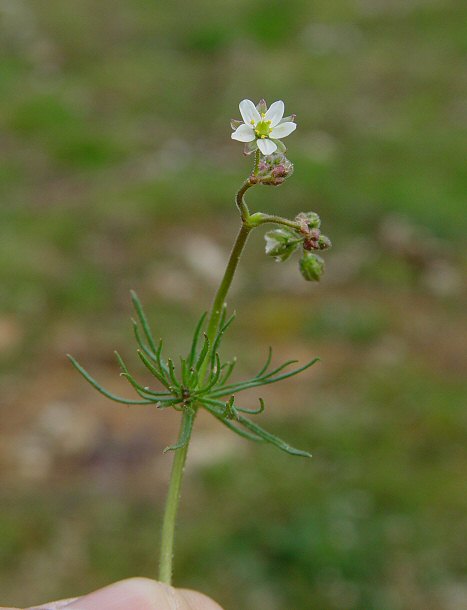Spergula arvensis L.
Corn Spurrey

Introduced
CC = *
CW = 5
MOC = 2
© DETenaglia
Spergula arvensis L.Corn Spurrey | |
 |
Introduced CC = * CW = 5 MOC = 2 |
© DETenaglia |
|
Family - Caryophyllaceae Habit - Annual forb. Stems - Spreading to erect, to 50 cm, unbranched or branched (especially above the midpoint), glabrous or moderately to densely pubescent with short, stalked glands.
Leaves - Opposite but appearing whorled, with 2 axillary clusters of 8-15 each per node, these all fused basally into an inconspicuous ridge around the stem, sessile. Stipules arising from the basal ridge, 4 per node, thin and white, broadly ovate to triangular, angled or tapered to a bluntly or sharply pointed tip, sometimes narrowly notched at the tip. Leaf blades 1.5-3.0 cm long, hairlike to linear, sometimes succulent, more or less tapered at the base, angled to a bluntly or sharply pointed tip, glabrous or with sparse, short, stalked glands.
Inflorescences - Open terminal clusters, 0.4-1.5 cm long, erect to ascending, at fruiting angled downward from the base, the bracts paired, resembling minute leaves. Flowers - Sepals 5, fused toward the base, the fused portion short and saucer-shaped, the lobes 3.5-5.0 mm long, elliptic to ovate-elliptic, green or purplish-tinged, rounded or angled to a bluntly pointed tip, the margins thin and white, the outer surface glabrous or glandular-hairy. Petals 5, relatively inconspicuous, 2-3 mm long, shorter than to about as long as the sepals and attached along the rim of the calyx tube, more or less ovate, narrowed or short-tapered but not to a stalklike base, rounded to bluntly pointed at the tip, white, lacking appendages. Stamens usually 10, the filaments distinct, attached to the rim of the calyx tube. Staminodes absent. Pistil with 1 locule, the ovary sessile. Styles 5, each with a stigmatic area along the inner surface.
Fruits - Capsules 3.5-5.0 mm long, dehiscing apically to near the midpoint by 5 spreading or recurved valves. Seeds 5-25, 1.0-1.1 mm wide, subglobose, the surface often appearing pebbled or with minute, white papillae, black, often with a 0.1 mm wide, white wing. Flowering - May - October. Habitat - Disturbed sites, sandy fields, cultivated sites, railroads. Origin - Native to Europe. Lookalikes - None. Other info. - This interesting but weedy species has been reported in just 2 Missouri counties thus far. The two collections were both prior to 1920, and it is possible that the species no longer exists in Missouri. Within the continetnal U.S. it has been found mainly in the coastal and Great Lakes regions. The plant can be identified by its ascending stems, whorled, threadlike leaves, glandular-pubescent pedicels, and small white flowers. A single plant can produce many flowers and seeds and thus, become a persistent spring weed. Photographs taken at Auburn University, AL., 2-19-05 (DETenaglia). |